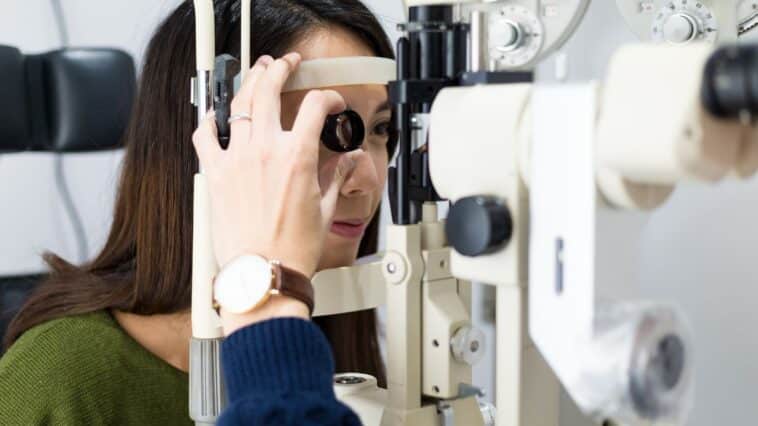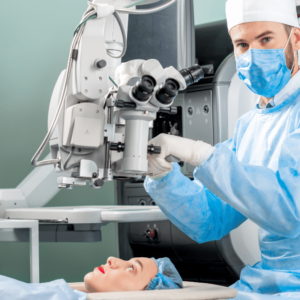What is Lazy Eye?
Lazy Eye, also known as Amblyopia, is a visual disorder where the vision in one eye does not develop properly during childhood. This can happen if the eye does not receive enough visual stimulation or if the eye and brain do not work together effectively.
A lazy eye can lead to reduced visual acuity, depth perception, and stereoscopic vision in the affected eye, but it can be treated with vision therapy and/or corrective lenses.
What are the Symptoms of Lazy Eye?
The symptoms of lazy eye, also known as strabismus, can include:
- Eye misalignment: The affected eye may turn inward, outward, upward, or downward while the other eye looks straight ahead.
- Double vision: People with the lazy eye may experience double vision when looking at an object with both eyes open.
- Poor depth perception: Misaligned eyes can make it difficult to judge distances accurately.
- Eyestrain: People with the lazy eye may experience discomfort, fatigue, or headaches when using their eyes for extended periods.
- Amblyopia: Lazy eye can also lead to amblyopia, which occurs when the brain stops using the affected eye.
Symptoms of lazy eye can vary in severity and duration, and some people may have no symptoms. A comprehensive eye exam and consultation with an eye doctor can help determine the presence and severity of the lazy eye and determine the best course of treatment.
Lazy eye surgery symptoms differ from the potential risks and complications associated with the surgical procedure. After the surgery, people may experience temporary discomfort, blurred vision, or double vision, but these symptoms usually resolve within a few days or weeks.
If you experience persistent or worsening symptoms after lazy eye surgery, you must consult your eye doctor as soon as possible.
What are the Risks of Lazy Eye Surgery?
Lazy eye surgery is a procedure performed to correct misaligned eyes. As with any surgical procedure, there are potential risks and complications associated with lazy eye surgery, including:
- Infection: There is a small risk of infection following surgery, which can cause pain, redness, and swelling.
- Bleeding: There is a risk of bleeding during or after surgery, which can cause swelling and discomfort.
- Double vision: In some cases, surgery may cause double vision, which can be temporary or permanent.
- Over-correction or under-correction: Surgery may not achieve the desired outcome, and the eye may still be misaligned, or the correction may be too excellent, causing double vision.
- Dry eye: Dry eye is a common side effect of lazy eye surgery, which can cause discomfort and decreased tear production.
- Visual field loss: In rare cases, surgery may result in visual field loss, which can cause difficulty with peripheral vision.
- Re-operation: In some cases, a second surgery may be required to achieve the desired result.
It is essential to discuss the potential risks and complications of lazy eye surgery with your surgeon and to carefully weigh the potential benefits against the risks before deciding if surgery is right for you. Your surgeon can also provide more information about surgery’s specific risks and benefits for your individual condition.
Diagnosis and Treatment Options
An eye doctor typically diagnoses the lazy eye through a comprehensive eye exam that includes visual acuity tests, assessment of eye alignment and eye movements, and evaluation of depth perception.
Treatment options for lazy eye include:
- Glasses or Contact Lenses: Corrective lenses can help to improve vision and reduce the effects of refractive errors that may contribute to lazy eyes.
- Vision Therapy: Vision therapy, also known as perceptual training, can help to retrain the brain to use the affected eye. This may involve exercises to improve eye movement, coordination, and visual perception.
- Patching: Patching the good eye for a specified amount of time each day can force the brain to use the weaker eye, promoting visual development.
- Atropine drops: Atropine drops can blur the vision in the good eye, promoting the use of the affected eye and improving vision over time.
- Combination Therapy: A combination of glasses, vision therapy, and patching may be used to treat lazy eyes.
It is essential to seek prompt treatment for lazy eyes, as the condition can become more difficult to treat as child ages. Early diagnosis and intervention can improve outcomes and prevent long-term visual problems.
Benefits of Lazy Eye Surgery
Lazy eye surgery, also known as strabismus surgery, is a surgical procedure that can be used to treat misaligned eyes. The benefits of lazy eye surgery include the following:
- Improved eye alignment: Surgery can realign the affected eye, allowing it to work together with the other eye to provide clear, comfortable vision.
- Increased visual acuity: By improving eye alignment, surgery can help to improve visual acuity and reduce the effects of double vision.
- Improved depth perception: Surgery can help to improve depth perception by allowing the eyes to work together more effectively.
- Better cosmetic appearance: Misaligned eyes can be noticeable and unsightly, and surgery can improve the cosmetic appearance of the eyes.
- Increased confidence: Improved vision and appearance can increase self-esteem and confidence in individuals with lazy eyes.
Surgery is not always necessary for lazy eyes, and other treatments such as glasses, vision therapy, and patching may be more appropriate in some cases. A comprehensive eye exam and consultation with an eye doctor can help determine the best course of treatment for a particular individual.
Preparing for Surgery and Aftercare Tips
Preparing for lazy eye surgery typically involves the following steps:
- Comprehensive eye exam: Before undergoing surgery, it is essential to have a comprehensive eye exam to determine the best course of treatment for your specific condition.
- Consultation with a surgeon: A consultation with a strabismus surgeon can help you understand the risks, benefits, and expectations of surgery and help you make an informed decision about whether surgery is right for you.
- Medical evaluation: Your surgeon may require a medical evaluation to determine if you have any underlying health conditions that could affect the success of the surgery.
- Stop wearing contact lenses: If you wear contact lenses, you may be asked to stop wearing them for a specified period before the surgery.
Aftercare tips for lazy eye surgery include:
- Follow your surgeon’s instructions: It is essential to follow them carefully, including any instructions for postoperative care and medications.
- Protect your eyes: You should avoid rubbing or bumping them after surgery and protect them from dust and other irritants.
- Wear protective eyewear: You may be advised to wear protective eyewear, such as glasses or a shield, to protect your eyes during the healing process.
- Attend follow-up appointments: Regular appointments with your surgeon can help monitor your progress and ensure your eyes are healing correctly.
- Engage in vision therapy: Your surgeon may recommend additional vision therapy after surgery to help improve visual acuity and eye coordination.
It is essential to follow your surgeon’s instructions carefully and attend all follow-up appointments to ensure the best possible outcome after lazy eye surgery.
How Much Does Surgery for a Lazy Eye Cost?
The cost of lazy eye surgery, also known as strabismus surgery, varies depending on several factors, including the type of surgery, the location of the surgery, and the surgeon’s experience and reputation.
In general, the cost of lazy eye surgery can range from several thousand dollars to tens of thousands of dollars, with the average cost being between $5,000 to $10,000.
It is important to note that the cost of lazy eye surgery may not be covered by health insurance, and some insurance plans may have strict requirements for coverage, such as a requirement for prior authorization or a demonstration that other forms of treatment have been ineffective.
To determine the exact cost of lazy eye surgery, it is best to consult a strabismus surgeon or eye doctor and obtain a detailed estimate of the costs involved. You can also check with your insurance company to determine what, if any, costs will be covered.
Conclusion
A lazy eye, or strabismus, is a condition that can affect vision and eye coordination. It can cause misaligned eyes, double vision, poor depth perception, and eyestrain. Surgery can be an effective treatment option for some people with lazy eyes who have not responded to other forms of treatment, such as glasses, vision therapy, or patching. The goal of lazy eye surgery is to realign the affected eye and improve eye coordination.
However, it is essential to note that surgery is not always necessary for lazy eyes, and other forms of treatment, such as glasses, vision therapy, and patching, may be more appropriate in some cases. Additionally, there is a risk of complications associated with lazy eye surgery, including infection, bleeding, double vision, over-correction or under-correction, dry eye, visual field loss, and re-operation.
A comprehensive eye exam and consultation with an eye doctor can help determine the presence and severity of the lazy eye and determine the best course of treatment for a particular individual. If you are considering lazy eye surgery, it is essential to consider the potential benefits and risks carefully and to discuss the procedure in detail with your surgeon.






